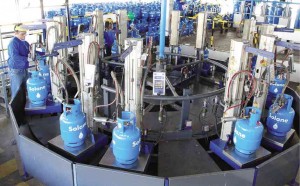Meet Solane, the former Shellane
MANILA, Philippines—With a new name that is still unfamiliar even to its old customers, Solane is counting on enhanced client service to reestablish itself in the liquefied petroleum gas (LPG) market, even increase its market share.
Ramon del Rosario, chief operating officer of Isla LPG Corporation (ILC), identified improved customer service as one of the key strategies for making Solane the leader in the market. Solane is the brand given to the former Shellane by Isla Petroleum and Gas Corporation, a Filipino-Japanese partnership, after acquiring the product from Shell.
Toshihisa Fuse, ILC chief executive officer, says, “To pursue our prospects for the company, we will continue to understand and internalize the needs of all our customers—from all our different product segments. Once we do that, we will custom-fit our offer and provide value propositions that respond to their unique needs.”
Solane’s efforts to strengthen consumer confidence in its products, particularly the strong focus on safety measures, will no doubt also help boost trust in LPG itself. The popular household cooking fuel, which has also acquired the reputation as a cleaner motor vehicle fuel, has lost some of its shine as it has been suspected to have caused a number of fires. As a motor vehicle fuel, some studies suggest it is causing respiratory ailments in both drivers and passengers.
But, as Solane officials explains, the problem often was more of quality control, not the product itself.
In motor vehicles, for instance, many conversions from diesel or gasoline to LPG are done by people who have had no formal training but merely spent a few hours watching somebody do it. The result is a tank that leaks gas into the vehicle causing discomfort, even sickness, to everyone in it.
As for household users, a common problem is failure to check if the hose and/or regulator is still in good working condition. Safety rules require that both hose and regulator should be replaced after five years or so. But even before replacement is due, users are supposed to check constantly for leaks.
Concerns have also been raised about the quality of tanks used. Some LPG containers are so rusty, the user faces the risk not only of it blowing him/her up, but getting tetanus, too. There were also reports of tanks being smuggled in separate pieces then welded together by distributors. Like the car tank conversion, work is often done haphazardly resulting in leaks.
Thus, an important part of Solane’s service for household clients is a seven-point check. Exclusive to Solane, it is done every time a new tank is delivered through its Hatid Bahay service. When the Solane delivery person comes knocking on a customer’s door, he will not only bring a new tank but do a seven-point check of the LPG setup unless, of course, the client refuses.
The seven-point safety checklist covers safety of the environment (where the tank is installed and used), condition of the O ring, type of regulator used, proper connection between cylinder valve and regulator, proper type of hose, attachment of the hose to the regulator and appliance and quality of flame.
Del Rosario says an LPG-fueled stove that was working properly should emit a blue flame. He adds that, with Solane, flame that was turning yellow would be an indication a replacement tank would soon be needed.
In a visit to Isla’s plant in San Fernando, Pampanga, media visitors were shown how Solane products underwent different levels of safety and quality checks before they were sent out to distributors and sold to households. Isla has its tanks manufactured and the containers have dates imprinted on them to guide the company when to do a quality check—every five years for new ones. Those that have outlived their usefulness are crushed before leaving the plant for the junkyard so they could not be used by anyone else.
Isla also guarantees consumers that they get all the LPG they pay for—if the tank says 11 kilos, buyers will get every drop of that volume as weighing scales are calibrated everyday and government inspectors come every six months to check that they have not been tampered with.
Carisse Dawn J. Vendiola, marketing officer, says Isla was making it easy for consumers, using different brands, to shift to Solane. All they had to do was have a tank delivered and the courier would do the required seven-point check, she says. If the tank was in good condition and the hose and regulator suited to the Solane tank and in good working order, the customer would be asked to pay only for the contents of the tank.
Additional fees would depend on what needed to be changed, Vendiola says. At the moment, though, those who want to switch can avail themselves of Isla’s free A/S regulator. Call the Hatid Bahay hotline to kmow more about the switch offer. In Metro Manila, customers can call 887555. Those everywhere else can contact 0918-8875555 by short message service (text) only.

